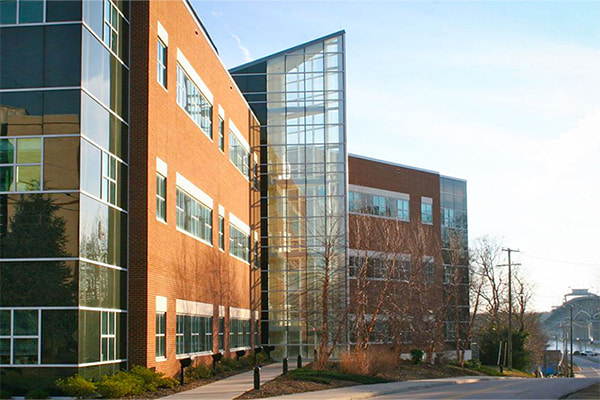
Ceremony to dedicate new aquaculture facility features representatives from academia, state government, and the shellfish-farming community.
Archived Top Stories

Ceremony to dedicate new aquaculture facility features representatives from academia, state government, and the shellfish-farming community.
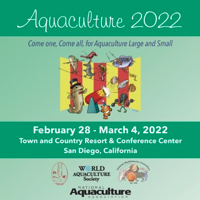
VIMS grad students Alex Marquardt and Anna Poslednik impressed at the Aquaculture 2022 conference in San Diego, earning both presentation awards bestowed by the National Shellfisheries Association.

Dr. Bill Walton, Acuff professor of marine science, seeks to foster a thriving, sustainable industry.

A VIMS-led team will use funds from NOAA to help oyster growers and restoration specialists better manage their future responses to acidification in the Chesapeake Bay.
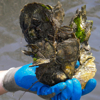
Oysters once dominated the Chesapeake Bay ecosystem, and it would be difficult, if not impossible, for the Bay to return to full ecological health without restoring its apex filterer.

A field study by VIMS researchers shows minimal impacts from oyster aquaculture overall in the Chesapeake Bay, suggesting that low-density oyster farms located in well-flushed areas are unlikely to impair local water quality.

A study initiated by Dr. Ryan Carnegie of VIMS reveals that oyster aquaculture can limit the spread of disease among wild populations of the tasty bivalve. The findings counter long-held beliefs that diseases often spread from farmed to wild populations.
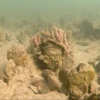
VIMS researchers lead development of online tool that quantifies oysters’ contribution to “pollution diets” designed to restore water quality in Chesapeake Bay.

Unusually fresh waters have impacted everything from algal blooms to fish distributions, oyster mortality and disease prevalence, the conduct of lab experiments, and the incidence of low-oxygen dead zones.
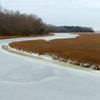
In an era of sea-level rise and global warming, almost two weeks of low tides and chilly temps has raised a host of questions, as well as concerns among vessel operators and oyster growers. VIMS professors help explain the apparent contradictions.
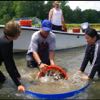
Shows that reefs built to reach a foot or more above the bottom develop into healthy, self-sustaining ecosystems, while those rebuilt at lower heights are quickly buried by sediment.

Oyster growers in Virginia’s portion of Chesapeake Bay can apply for funding through USDA’s Regional Conservation Partnership Program to help restore oyster beds on private shellfish grounds.
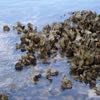
VIMS-led study is the first to identify and quantify potentially denitrifying bacteria in the oyster gut and shell, with important implications for efforts to reduce nutrient levels in coastal waters through oyster restoration.

Annual survey of shellfish aquaculture shows Commonwealth's growers sold $56.6 million in clams and oysters in 2016.
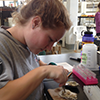
Four rising professionals recently completed a training program in oyster aquaculture at the Virginia Institute of Marine Science, providing them with the skills needed to advance in this rapidly growing industry.
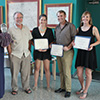
Four emerging professionals needed to advance Chesapeake Bay’s rapidly growing oyster aquaculture industry received certificates of completion during a reception at VIMS last week.

A global analysis of the scientific literature shows that VIMS professors hold 4 of the top-20 spots in production of oyster-related research.
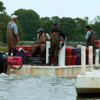
Annual survey of shellfish aquaculture shows Commonwealth's growers sold $55.9 million in clams and oysters in 2014, up 24% from 2013.
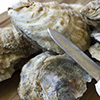
VIMS graduate student Lydia Bienlien and researchers Ryan Carnegie, Corinne Audemard, and Kimberly Reece are conducting a study that could make us rethink the way we are breeding oysters.

VIMS researchers join with colleagues, shellfish farmers, and government officials to explore options for improving management of oyster and clam diseases along the U.S. East Coast.

VIMS recently celebrated the sixth group of interns to graduate from its Oyster Aquaculture Training Program during a reception on the Gloucester Point campus.
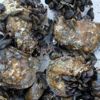
Research shows that the mussels that typically colonize a restored oyster reef can more than double its overall filtration capacity.

Inventor of the Year Award to Dr. Stan Allen recognizes his patented method for producing spawnless oysters, which has revolutionized aquaculture worldwide.
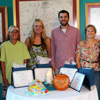
The Virginia Institute of Marine Science recently celebrated the graduation of four emerging professionals needed to advance Chesapeake Bay’s rapidly growing oyster-farming industry.

The Virginia Institute of Marine Science recently welcomed the fifth group of interns to its six-month Oyster Aquaculture Training Program (OAT) to learn the skills needed to enter Chesapeake Bay’s rapidly growing oyster-farming industry.
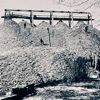
VIMS Professor Roger Mann and colleagues explore the ability of oyster reefs to buffer the increasing acidity of ocean waters.

A study led by VIMS researcher Lisa Kellogg shows that a restored oyster reef can remove up to 10 times more nitrogen from Chesapeake Bay waters than an unrestored area nearby.
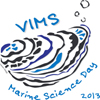
VIMS chooses Lauren Gregg as the Grand Prize winner in its annual Marine Science Day artwork contest.

Gloucester gallery showcases the talents of local artists who submitted entries to this year's Marine Science Day oyster artwork contest.

The Virginia Institute of Marine Science recently celebrated the graduation of four emerging professionals who will be joining the ranks of Chesapeake Bay’s rapidly growing oyster aquaculture industry.
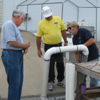
A recent gathering of “Master Oyster Gardeners” is the latest chapter in a fruitful partnership between VIMS scientists and members of the Tidewater Oyster Gardeners Association, or TOGA.

Report shows Virginia’s oyster aquaculture industry is growing steadily despite the struggling economy and some setbacks in hatchery production.

Local oyster growers learn how ocean acidification may affect their operations, and how they could best respond.
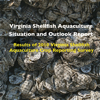
A new report from VIMS and Virginia Sea Grant shows the Commonwealth’s oyster aquaculture industry is poised to begin its biggest growth spurt ever.
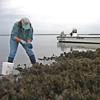
Development of disease resistance among Chesapeake Bay oysters calls for a shift in oyster-restoration strategies within the Bay and its tributaries.

The Tidewater Oyster Gardeners Association has provided VIMS with an initial gift of $27,000 to establish the TOGA Fellowship Endowment in support of research by VIMS graduate students.
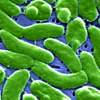
Local oyster growers and VIMS researchers find that moving farmed oysters into saltier waters just prior to harvest nearly eliminates the presence of a bacterium that can sicken humans.

Professor emeritus Dexter Haven was a pioneer in early shellfish studies in Chesapeake Bay, and lead author of what many consider the seminal paper on the Bay's oyster stock and fishery.

A new study co-authored by VIMS professor Mark Luckenbach shows that decline of oyster reefs is not confined to Chesapeake Bay.

Governor Bob McDonnell has appointed professors Carl Hershner and Roger Mann to state advisory boards concerned with water resources and aquaculture.

Report estimates total, "water-to-table" losses of $30.1 million as imports of Gulf oysters dry up.
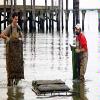
Sales of Virginian-grown shellfish show mixed response to the slowing economy. Plantings and projections of Virginia's oysters and clams were also mixed in 2009.
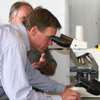
Visit coincides with a growing recognition that increased disease resistance, a local surge in oyster aquaculture, and recently announced federal restoration goals promise new opportunities for restoring Bay oysters.
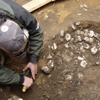
A VIMS study of 400-year-old oyster shells from the Jamestown settlement confirms that a harsh drought plagued the early years of the colony and made the James River much saltier than today.

The Lynnhaven River Oyster Restoration Team is honored for innovative efforts to restore the river's oyster population.

VIMS' 50-year monitoring program shows that Chesapeake Bay oysters are developing resistance to the diseases that have helped devastate their population.
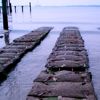
Aquaculture experts will present at this year's Virginia Aquaculture Conference on November 13 and 14 in Williamsburg, VA.
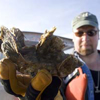
A 5-year study of oyster-restoration techniques in Chesapeake Bay shows that taller reefs in an extensive network of large sanctuaries is critical for re-establishing self-sustaining populations of native oysters.
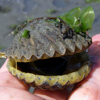
VIMS researchers will collaborate with public and private partners on a new effort to restore oysters, seagrass, and bay scallops to Virginia's seaside bays.
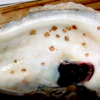
A survey of Virginia’s oyster farmers shows a dramatic increase in the number of seed and larvae sold between 2007 and 2008. The survey, by VIMS’ Sea Grant Extension Program, also found that hatcheries predict an additional 4-fold increase in sales for 2009.
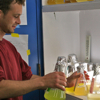
VIMS begins a new program to train the skilled workers needed to advance Chesapeake Bay’s rapidly growing oyster-farming industry.

Booklet outlines methods for “spat-on-shell” oyster culture.

A survey by researchers with the Sea Grant program at VIMS shows that shellfish farmers planted more than half a billion clams and 18 million oysters in Virginia waters last year. The annual survey, which began three years ago, marks the first effort to track economic trends in shellfish aquaculture in the Commonwealth.

Contractors will tomorrow begin seeding 3.8 acres of newly constructed reefs in the Great Wicomico River with 15 million disease-tolerant native oysters. The project culminates more than a decade of effort by state and federal agencies and non-profit citizen groups.